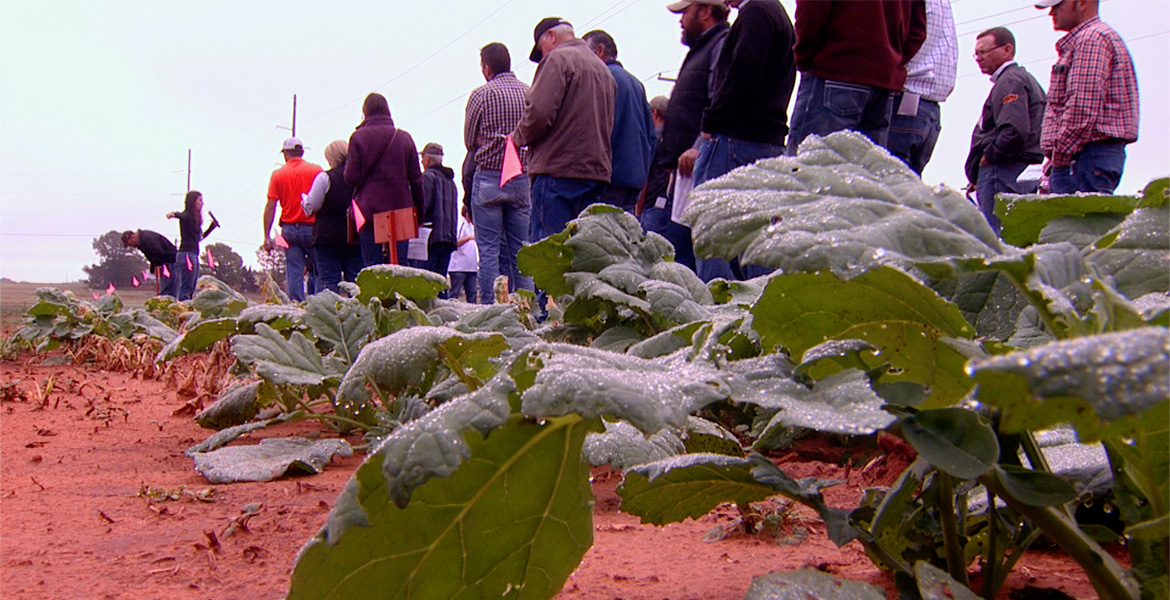
Producers facing weed pressure from summer and winter annuals
Thursday, October 18, 2018
Rainy and, at least until lately, warm weather means winter wheat growers are already facing weed pressure.
In fact, producers are seeing both summer and winter annuals popping up in their fields, said Misha Manuchehri, Oklahoma State University Cooperative Extension weed specialist.
“Producers who already have planted have some winter annuals coming up,” she said. “I’ve received many calls on pigweed, specifically Palmer amaranth, that emerged in earlier-planted wheat. Typically, this is a time when it’s too late for them to germinate, but not this year.”
Manuchehri pointed to the abundance of recent moisture and elevated temperatures into October as major causes of the current weed pressure.
“The rain, for sure, has played a role, and then up until we had this cold period, we were still relatively warm,” she said. “Soil conditions were warm, so we had some later germination of summer annuals and we’re dealing with that now.”
For producers who already have planted a crop and have weeds emerging, there are some herbicide options available. If they decide to go that route, Manuchehri recommended paying close attention to product labeling and application timing as wet and cool conditions may contribute to increased crop injury.
“Some of our postemergence products require a couple leaves on wheat,” she said. “If we’re going out with a delayed preemergence herbicide, we need activation by rain. Those preemergence herbicides sit on the soil surface. Our weed seeds are beneath the surface so they need to be moved into the soil profile where our weed seeds are located.”
One of the best management practices for producers who have yet to plant is beginning with a clean field. Doing so, either via herbicide or tillage, gives the crop a competitive advantage and can prevent the need for early postemergence applications that might injure the crop.
“I know we’re all getting anxious to get our seed in the ground. I am, as well. But, we need to make sure our crop has an opportunity to succeed,” she said.
Producers, Extension personnel, herbicide company representatives, crop consultants and other stakeholders from across the agriculture industry can learn more about best weed management practices in small grains at the upcoming 2018 Herbicide Symptomology Clinic, Oct. 26, OSU Agronomy Research Station, Highway 51 and August Road, Stillwater.
Free and open to the public, the highly interactive and hands-on clinic begins at 9 a.m., with coffee and donuts served at 8:30 a.m. An RSVP is requested.
In addition to learning about common preemergence and postemergence herbicide symptomology from Manuchehri, participants also will hear crop updates from other OSU Extension specialists and an auxin-tolerant crop update.
There also will be a pesticide application technology demonstration.
“For much of the clinic, people are on the ground looking at the plants, looking at what the herbicide symptom is and if the product is one they can use in their cropping system,” Manuchehri said.
One of the anticipated highlights of this year’s clinic is a new herbicide-tolerant wheat that is tolerant to a new formulation of quizalofop-P-ethyl, a postemergence herbicide that kills many grass weeds.
“Most growers haven’t seen this new technology or know very little about it, so that will be new,” Manuchehri said.
Participants can earn up to two CEU credits through the Oklahoma Department of Agriculture for attending the clinic.
“There are many herbicide products and it can be overwhelming. You have to think of the trade names, common names and chemical names. It can be a lot,” Manuchehri said. “We don’t always know what tools we have available when we go into the season. The clinic provides attendees with a refresher on older chemistries and what’s new.”
Contact Manuchehri at misha.manuchehri@okstate.edu or 405-744-9588 for more information about the Herbicide Symptomology Clinic.
Producers also can watch SUNUP Oct. 20 as Manuchehri discusses the weed pressure growers are experiencing and previews the upcoming clinic. SUNUP airs Saturdays at 7:30 a.m. and Sundays at 6 a.m. on OETA or visit sunup.okstate.edu.
To gain more insight into weed management best practices, contact the nearest county Extension office and download free OSU Fact Sheets on the topic, including PSS-2750, “Guide to Effective Weed Control” and PSS-2778, “Herbicide How-To: Understanding Herbicide Mode of Action,” at factsheets.okstate.edu.
Story by Leilana McKindra
